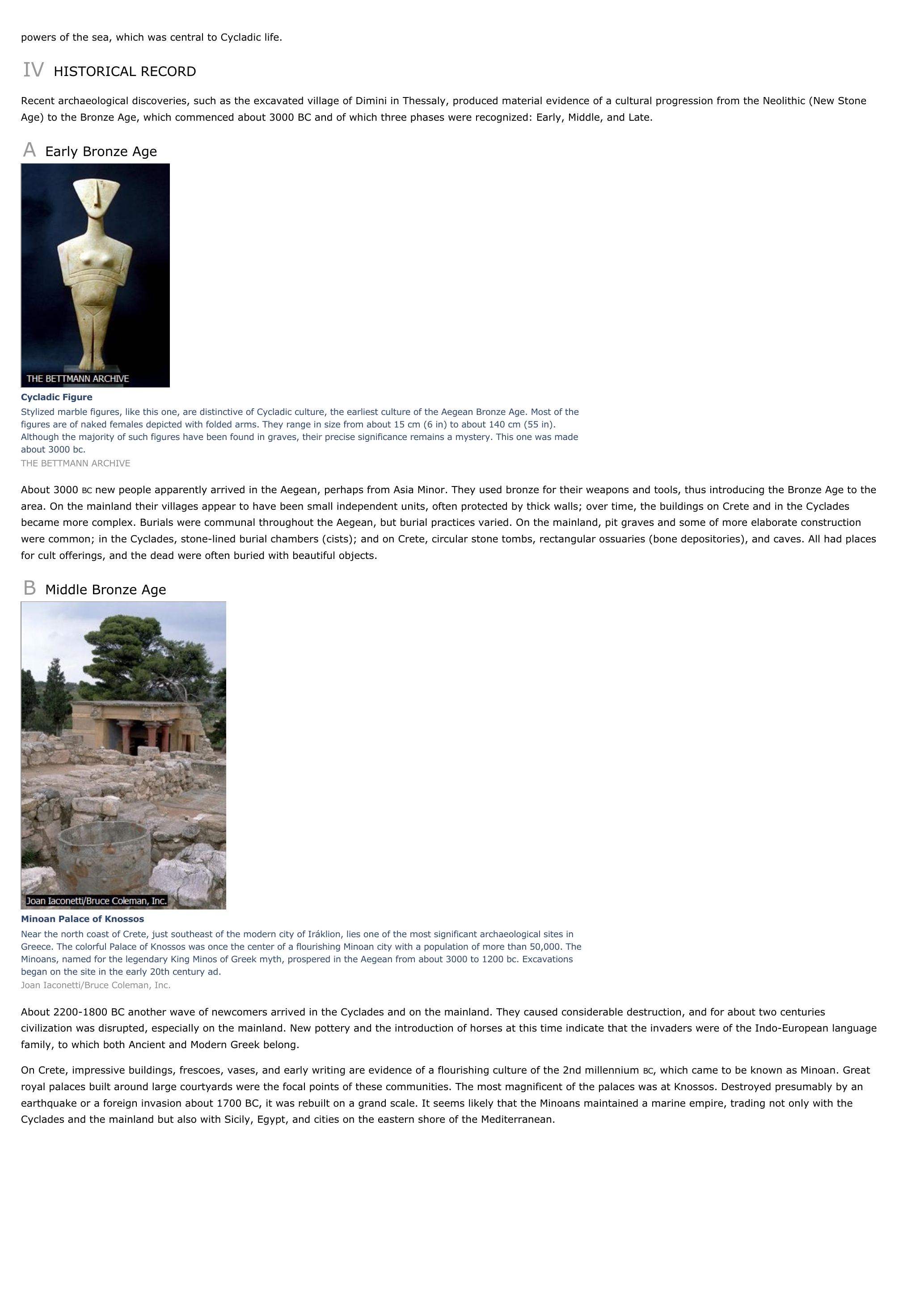Aegean Civilization - history.
Publié le 26/05/2013

Extrait du document
«
powers of the sea, which was central to Cycladic life.
IV HISTORICAL RECORD
Recent archaeological discoveries, such as the excavated village of Dimini in Thessaly, produced material evidence of a cultural progression from the Neolithic (New StoneAge) to the Bronze Age, which commenced about 3000 BC and of which three phases were recognized: Early, Middle, and Late.
A Early Bronze Age
Cycladic FigureStylized marble figures, like this one, are distinctive of Cycladic culture, the earliest culture of the Aegean Bronze Age.
Most of thefigures are of naked females depicted with folded arms.
They range in size from about 15 cm (6 in) to about 140 cm (55 in).Although the majority of such figures have been found in graves, their precise significance remains a mystery.
This one was madeabout 3000 bc.THE BETTMANN ARCHIVE
About 3000 BC new people apparently arrived in the Aegean, perhaps from Asia Minor.
They used bronze for their weapons and tools, thus introducing the Bronze Age to the area.
On the mainland their villages appear to have been small independent units, often protected by thick walls; over time, the buildings on Crete and in the Cycladesbecame more complex.
Burials were communal throughout the Aegean, but burial practices varied.
On the mainland, pit graves and some of more elaborate constructionwere common; in the Cyclades, stone-lined burial chambers (cists); and on Crete, circular stone tombs, rectangular ossuaries (bone depositories), and caves.
All had placesfor cult offerings, and the dead were often buried with beautiful objects.
B Middle Bronze Age
Minoan Palace of KnossosNear the north coast of Crete, just southeast of the modern city of Iráklion, lies one of the most significant archaeological sites inGreece.
The colorful Palace of Knossos was once the center of a flourishing Minoan city with a population of more than 50,000.
TheMinoans, named for the legendary King Minos of Greek myth, prospered in the Aegean from about 3000 to 1200 bc.
Excavationsbegan on the site in the early 20th century ad.Joan Iaconetti/Bruce Coleman, Inc.
About 2200-1800 BC another wave of newcomers arrived in the Cyclades and on the mainland.
They caused considerable destruction, and for about two centuriescivilization was disrupted, especially on the mainland.
New pottery and the introduction of horses at this time indicate that the invaders were of the Indo-European languagefamily, to which both Ancient and Modern Greek belong.
On Crete, impressive buildings, frescoes, vases, and early writing are evidence of a flourishing culture of the 2nd millennium BC, which came to be known as Minoan.
Great royal palaces built around large courtyards were the focal points of these communities.
The most magnificent of the palaces was at Knossos.
Destroyed presumably by anearthquake or a foreign invasion about 1700 BC, it was rebuilt on a grand scale.
It seems likely that the Minoans maintained a marine empire, trading not only with theCyclades and the mainland but also with Sicily, Egypt, and cities on the eastern shore of the Mediterranean..
»
↓↓↓ APERÇU DU DOCUMENT ↓↓↓
Liens utiles
- Aegean Civilization - USA History.
- Maya Civilization - history.
- Indus Valley Civilization - history.
- Aegean Civilization .
- Indus Valley Civilization - History.
















